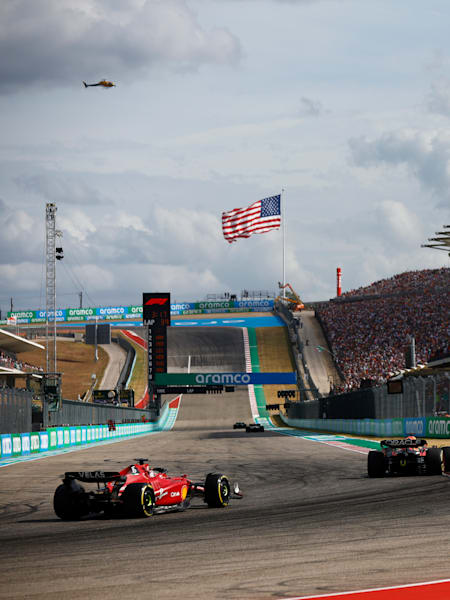The high-speed excitement surrounding any Formula 1 (F1) race is palpable. From extreme weather to extra pit stops, there are always situations that raise the stakes. Red Bull racers Max Verstappen, Sergio Pérez, Daniel Ricciardo and Yuki Tsunoda knows how intense and quick races can be.
No matter what happens on the track, though, each F1 race takes around the same time with each round. Learn more about how long an F1 race lasts and the different factors that affect that length.
01
The average duration of an F1 Race
A typical F1 Grand Prix race lasts about 90 minutes, although racers are allotted about two hours to complete all laps. An F1 race tends to reach the full two-hour mark when the action slows down during Safety Car periods or when red flags bring everything to a stop. The race distance is standardized to a minimum distance of 305 kilometers, or approximately 190 miles.
However, there is a notable exception — the Monaco Grand Prix. This iconic race covers a shorter distance of 260 kilometers (160 miles) due to its challenging street circuit layout, comprising 78 laps through the narrow and winding roads of Monaco.
Notable exceptions and outliers to the average Formula 1 race time
The Monaco Grand Prix stands out as a significant exception in terms of race distance and duration. The Fairmont Hairpin, the slowest section of the 260 km track, has drivers navigate terrain below 31 mph. The fastest Monaco Grand Prix section lets drivers take a turn over 162 mph. However, drivers typically stick to slower speeds for the Monaco Grand Prix so they can maximize grip over the amount of turns there are.
Conversely, some races have exceeded the average duration due to extraordinary circumstances. Notably, the 2011 Canadian Grand Prix lasted over four hours due to heavy rain and multiple stoppages. This race made history as the longest race to date.
Even practice sessions can be affected by weather. On the first day of the 2024 Chinese Grand Prix, a fire occurred with rain downpouring. The first fire prompted a 20-minute red flag — and kept recurring, causing even more confusion.
02
Factors affecting race duration
Track layout and length
Traditional race tracks, with their long straights and sweeping corners, often facilitate faster lap times. Street circuits, such as those found in Monaco or the Las Vegas Grand Prix, often have slower lap times.
Street circuits tend to be tighter and more complex, demanding greater precision and overall taking longer to complete. For instance, the Las Vegas Strip Circuit race spans 3.8 miles, with 17 high-speed turns and two drag reduction system (DRS) zones. Drivers can reach speeds topping 215 mph as they race by Las Vegas’ iconic landmarks.
Weather conditions and their impact
Weather also plays a role in the length of an F1 race. Rain can dramatically alter race conditions. Slick roads result in reduced grip and increased pit stops to check drivers’ tires, contributing to reduced lap times. The Belgian Grand Prix is infamous for its unpredictable weather.
Even hot temperatures can cause challenges for drivers. They’re susceptible to overheating in the cockpit, so drivers wear special suits to prevent extreme heat-related issues.
Safety cars and red flags
Physical and virtual safety cars are used to control the pace of the race during hazardous conditions, such as accidents or debris on the track. The deployment of the safety car can also affect the length of a race.
Similarly, a red flag indicates the suspension of a race because of an accident or dangerous conditions. Red flags can also be used to notify drivers that they need to slow down or go back to the pitlane because a hazard is present on the track.
These interruptions can extend the overall duration of the event.
Pit stops and team strategies
Teams carefully plan their pit stops to optimize tire performance and refuel. These stops, while essential for tire and car maintenance, add valuable seconds to a driver’s total race time. Effective strategy and seamless execution are a must to minimize delays and maintain competitive race times.
03
Formula 1 race times vs. other motorsport events
Compared to other motorsport events, F1 races are relatively short, yet intense.
NASCAR races, for example, typically last between two to four hours and cover a much greater distance. The 24 Hours of Le Mans, as the name suggests, is a marathon endurance race lasting a full day, demanding extreme stamina and focus from drivers and teams alike.
MotoGP races are closer to the F1 time and intensity. MotoGP usually lasts around 45 minutes to an hour, emphasizing high-speed performance and rider skill.
While each of those races can make anyone’s heart pound, F1 offers a unique combination of speed and strategy within a compact timeframe. The 107% time duration rule adds pressure to ensure drivers can be as fast as possible and secure top placement. The precise engineering, team tactics, and rapid decision-making required in F1 create a spectacle that is unmatched in the world of motorsport.
Crossing the finish line
An F1 race duration typically averages 90 heart-pounding minutes. Track layout, weather conditions, safety cars, and pit stop strategies influence the overall length of a race. While F1 races may be shorter than some other motorsport events, their intensity and the level of skill required make them uniquely captivating. Understanding these dynamics can deepen one's appreciation for the sport and the extraordinary efforts of the teams and drivers involved.










